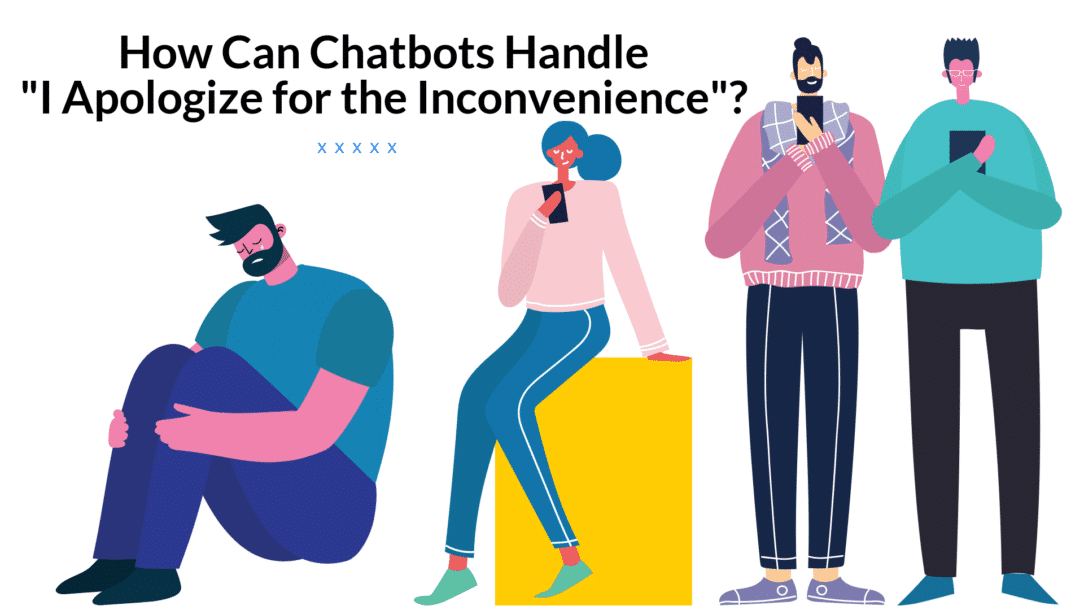Customers hate canned responses. Yet, “I apologize for the inconvenience” is everywhere. It’s robotic, overused, and worst of all—it doesn’t solve the problem.
Today’s customers expect more. They want real solutions, fast.
A study by PwC found that 73% of customers say a good experience is key to their brand loyalty, yet only 49% feel companies provide a good experience. If a chatbot only offers generic apologies, it’s missing the mark.
So, how can chatbots do better? Let’s break it down.
The Problem with “I Apologize for the Inconvenience”
According to a study by HubSpot, 93% of customers are more likely to be repeat buyers at companies with excellent customer service. A generic apology does not provide that.
Here’s why “I apologize for the inconvenience” fails:
| Problem | Why It Fails |
| Impersonal | Sounds like a script, not a real response. |
| No Accountability | Who’s at fault? Who’s fixing it? No clarity. |
| Zero Resolution | Apologies don’t solve problems. Solutions do. |
A bad apology frustrates customers. A great one builds trust. Let’s see how chatbots can turn apologies into opportunities.
The main problem with customer service is that it often feels impersonal. Customers want to be heard and acknowledged as individuals, not just another number in a company’s database. This is where chatbots can excel.
What Makes a Great Apology?
A solid apology has four key parts:
- Acknowledge the Problem – Show you understand their frustration.
- Empathy Matters – Customers want to feel heard.
- Own It – Take responsibility. No excuses.
- Fix It – Offer a clear solution.
💡 Example: ❌ “I apologize for the inconvenience.”
✅ “I see your order is delayed, Alex. That’s frustrating, and we’re on it! Here’s the latest update.”
Before we go into how can chatbots help, following points will help you understand what a real apology sounds like:
1) Empathize with the Customer
The first rule of a great apology is to show empathy. This means understanding and acknowledging the customer’s feelings. Use phrases like “I understand how frustrating this must have been for you” or “I can imagine how disappointed you must be feeling right now”. This shows that you are paying attention to the customer’s emotions and are taking them into consideration. You see, people want to feel understood and heard, especially when they are upset.
Example: “I understand how frustrating it must have been for you to wait so long for a response. I can imagine how disappointed and inconvenienced you must have felt.”
2) Take Responsibility
There is a saying, “The more responsibility you take, the more power you have.” This holds true for apologies as well. You need to take ownership of the mistake and not shift the blame onto someone or something else. This shows that you are willing to admit fault and are taking accountability for your actions.
Example: Let’s say a customer’s order was delayed due to an error on your end. Instead of saying “Our system had a glitch which caused the delay”, you should say “I take full responsibility for the delay in your order. It was due to an error on our part and I apologize for any inconvenience it may have caused.”
3) Offer a Solution
A genuine apology is not just about acknowledging the mistake, but also about finding a solution. After taking responsibility, offer a concrete plan to address the issue and make things right for the customer. What happens is, customers feel like their concerns are being taken seriously and they appreciate the effort to resolve the issue.
Example: “What I can do to make things right for you is expedite your order and provide a discount on your next purchase. We value your business and we want to ensure that you have a positive experience with us.”
4) Follow Up
The problem shouldn’t just end with the apology and solution. It’s important to follow up with the customer to make sure that they are satisfied with the resolution. This shows that you genuinely care about their experience and are willing to go the extra mile to ensure their satisfaction.
Example: “I wanted to check back in with you to see if everything went smoothly with your order after we resolved the issue. Is there anything else we can do for you?”
Why do these principles matter? Well, they show that you value your customers and their experiences. By empathizing with them, taking responsibility, offering a solution, and following up, you are building trust and showing genuine care for their satisfaction. This can lead to increased customer loyalty and positive word-of-mouth for your business. And in today’s competitive market, every happy customer counts! So remember these principles and use them to deliver sincere apologies and excellent customer service.
5) Maintain Professionalism
Hear me out, showing empathy and being sincere does not mean you have to be unprofessional. It’s important to maintain a professional tone while still being genuine in your apology. Avoid using slang or informal language and stick to a polite and courteous tone.
Example: “I apologize for the inconvenience caused by our mistake. We take full responsibility for it and are working to rectify the issue as quickly as possible.”
6) Learn from Your Mistakes
Lastly, it’s crucial to learn from your mistakes and use them as an opportunity for growth and improvement. Take note of what went wrong and how you can prevent similar issues from occurring in the future. This shows that you are committed to providing excellent service and continuously improving for the benefit of your customers.
Example: “We have taken measures to prevent this type of error from happening again in the future. We value your feedback and always strive to improve our processes for better customer experiences.”
How Chatbots Can Deliver Better Apologies?
Now that we understand the important principles of a good apology, let’s explore how chatbots can help businesses deliver better apologies in a timely and efficient manner.
A chatbot that simply says, “I apologize for the inconvenience,” without offering a real solution is as useful as an umbrella full of holes. Customers need more than a pre-programmed response—they need an interaction that feels helpful and human.
So, what should chatbots do instead?
Ditch the Script—Make It Sound Human
Imagine reaching out for help and getting a robotic, impersonal reply. Annoying, right? A chatbot should sound natural and engaging, not like it’s pulling lines from a customer service manual.
Instead of this:
“We apologize for any inconvenience this may have caused. Please let us know how we can assist further.”
Try this:
“I totally get how frustrating this must be. Let me check what’s going on and find the best solution for you!”
A little warmth and personalization can make a big difference.
Address the Issue—Don’t Just Acknowledge It
An apology without a fix is just empty words. If a customer reports a problem, they don’t just want you to acknowledge it—they want it solved.
For instance, if a delivery is delayed, don’t just say sorry. Give them details:
- What caused the delay?
- When can they expect their order?
- Is there anything you can do to make up for it?
“Looks like your package got stuck in transit. We’ve spoken to the courier, and it should arrive by Tuesday. If you need it sooner, I can check alternative options for you!”
See the difference? It’s about giving customers the information they actually need.
Know When to Step Aside
No matter how advanced chatbots become, there will always be situations where human intervention is necessary. The trick is knowing when to pass the baton.
A good chatbot should recognize frustration and escalate smoothly—without making customers repeat themselves.
“I see this is a bit complex. Let me connect you with a specialist who can help right away. I’ve shared the details, so you won’t have to explain again.”
This avoids the all-too-familiar cycle of repeating the same issue to multiple agents.
Follow Up Like You Mean It
A great customer experience doesn’t end when the issue is “resolved.” A follow-up can turn a frustrated customer into a loyal one.
“Hey Alex, just checking in! I see your refund was processed yesterday. Let us know if everything went smoothly or if there’s anything else we can do.”
It’s a small step, but it shows the brand actually cares.
Final Thoughts
A chatbot’s job isn’t just to answer—it’s to assist. If an automated response can make a customer feel heard, valued, and reassured, then it’s doing its job well.
So, the next time you design or train a chatbot, ask yourself: Is this response actually helpful, or is it just an empty apology?
Because in customer service, words matter—but actions matter more
Related Posts



